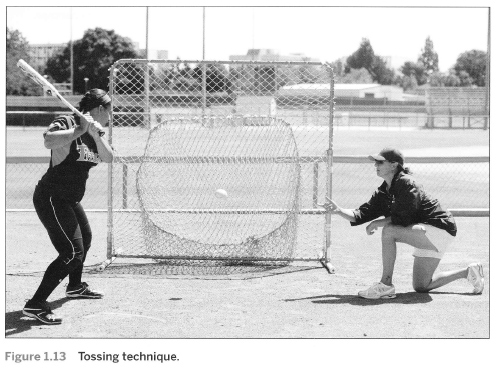| Toss Drills
by Judi Garman, Michelle Gromacki
A good toss is essential for toss drills to be productive. The toss should be firm and level with moderate speed. To increase the accuracy of the tosses, place balls on the ground as targets to mark the contact spots. The target can also be at the batter's front hip. Be safe! Make sure that the tosser is in a position where a ball or bat cannot hit her. Tosses are made from a kneeling or standing position, depending on the drill (see figure 1.13). Beginning players should toss from the side. More advanced players can toss from a 45-degree angle in front of the hitter. The tosser should use a backswing on the toss so that the hitter can key her timing off the arm. lf the batters start to "cheat" on soft-toss drills, tossers should hold one ball in either hand, rotate the balls (like juggling), and then toss one up. This way batters do not know when the ball is coming.  Purpose: To emphasize the pivot and keeping the hands and back elbow close to the body. Procedure: The tosser stands at a 45-degree angle in front of the hitter. She tosses Wiffle balls to the hitter's midsection. The hitter does not have a bat. From the stride position, the hitter pivots and catches (or hits) the ball with the back hand at a spot opposite the belly button. LOCATION TOSS Procedure: The tosser is in a kneeling position and tosses balls to the three spots where the batter should make contact. The tosser calls the number of the spot where she will toss the ball as she tosses it (she calls "one" for inside, "two" for middle, and "three" for outside). The hitter makes contact at that location, saying "hit" on contact. HIGH TOSS Procedure: The tosser throws from a standing position. The hitter hits tosses that are high inside and high outside. BACK TOSS Procedure: The tosser stands behind the batter. The batter turns her head slightly to track the ball. The toss should be on an inside-out path. The batter must wait on the ball, make contact out in front of the plate, and then drive hard through it.. TWO-BALL TOSS Procedure: While kneeling, the tosser throws two balls at the same time from one hand and calls which ball to hit. The tosser throws balls of different sizes or colors. She calls top or bottom, small or big, or a color. FRONT BOUNCE Procedure: The tosser stands about 15 feet (4.5 m) in front of the hitter. (The tosser can also be to the side: 6 feet [2 m] to the side and 3 feet [1 m] in front of the batter.) The tosser throws a tennis ball overhand, bouncing the ball up into the strike zone in front of the plate. The hitter uses the bounce as a trigger, or timing mechanism, to identify when she should take the hands back to launch position and begin the stride. SELF-TOSS UP THE MIDDLE Procedure: The hitter self-tosses and tries to take every ball up the middle. The hitter tosses the ball up with the bottom hand while resting the bat on the back shoulder. The toss should be to the contact spot and no more than a foot above it; using both hands to grip the bat, the player hits the ball as it descends. To avoid chasing balls, the hitter can stand 3 to 4 feet (1 to 1.5 m) from a fence and hit to it. Hit into a mat or use Wiffle balls to protect the fence. Alternatively, the player can stand at home plate and attempt to hit all balls over second base. She then repeats the drill, going from second base to home. (I [Judi] watched the famous Hall-of-Fame baseball star Ernie Banks do this drill at a clinic; he said he did it all the time as a player.) FRONT SCREEN TOSS Procedure: A screen standing about 15 feet (4.5 m) in front of the hitter protects the tosser. The hitter takes a normal swing, hitting the ball where it is pitched. She should drive outside pitches to the opposite field and pull inside pitches. The tosser holds the release on some pitches to make sure the batter is reacting to the ball and not the arm motion. ANGLE SCREEN TOSS Procedure: The tosser sets up the same distance as for the front screen toss but at an angle (to the right of the right-handed batter), while the hitter sets up normally in the box. The pitch will come at the batter like an outside pitch, and the hitter needs to hit it back at the net, going back to the opposite field. This teaches the inside-outside swing. QUICK HANDS Procedure: The tosser stands in front of the batter and behind a screen about 15 feet (4.5 m) in front of the hitter. The batter starts with the bat pointing at the tosser and must quickly get the hands back and forward to hit the tossed ball. SNAPBACKS Procedure: The tosser stands on the side of the batter or stands in front of the batter behind the screen. The tosser tosses the ball to one contact spot in rapid succession, not allowing the bat to come to rest. The batter does not have time to adjust to different locations, so the tosses should be consistent. The tosser throws 6 to 10 balls in a row. The hitter hits each ball hard, using a full swing. DOTTED BALLS Procedure: Four circles, each the size of a quarter, are marked on several balls. Some balls have red circles, and some have green circles. The tosser hides the colors with her glove. The hitter strides aggressively, prepared to hit every toss. She hits the green dotted balls and holds up on the red ones by squeezing the bat and tensing up. |
|
|







